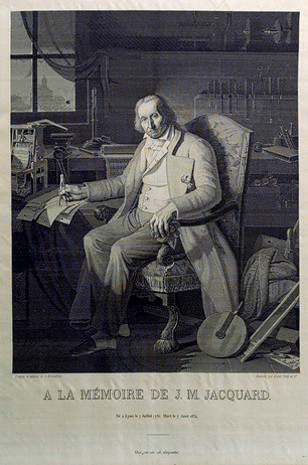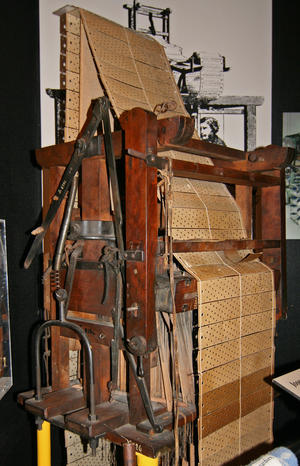Joseph Marie Jacquard
The story of Joseph Marie Jacquard reveals us some very interesting and important points. His invention revolutionized the textile industry and it’s an important milestone in computing (and robotics) history. But it’s not only about his invention.
It’s also a good example of how human knowledge tends to accumulate, and how society reacts to technological breakthroughs that can reduce costs and render some jobs unnecessary. Particularly – unrest of those people who are affected by these changes.

Joseph Marie Charles, called Jacquard, was born July 7th, 1752 in Lyon, Southern France in a silk weaver’s family. His father was a master silk weaver and he owned a weaver’s workshop, a vineyard, and a quarry. Despite this, Joseph Jacquard was illiterate until age 13.
In his childhood he worked at a weaver’s shop as a draw-boy. This job included sitting above the loom and re-positioning of warp threads in order to create the desired pattern, as ordered by the master weaver. Later, he created a machine that would do this tedious job in children’s place.
However, even if one of his personal motives was to liquidate this job, the main reason why his loom was invented was France’s rivalry with United Kingdom. As early as 1775 the French government started to subsidize innovations in perspective industries to foster economic growth.
So, inventive people at that time were encouraged to work on different innovations in different industries. Joseph Jacquard was one of them. As he was highly familiar with weaving, innovations of this process was an obvious choice.
As a starting point for his researches Joseph Marie Jacquard took an earlier automated loom design created by Jacques de Vaucanson. De Vaucanson’s design which itself was based on previous works of Basile Bouchon and Jean Falcon used a perforated paper roll to control the weaving process.
This design, however, wasn’t really well-working. So, Jacquard set to improve this design. It is said that by 1790 he managed to create an operational prototype of his loom. Those were turbulent times in history though.
The French revolution took place from 1789 to 1799. By 1793 Jacquard abandoned his project to join the republican lower classes in their fight against the French nobility. By 1801 he already had resumed his work on innovations of weaving process and his loom was displayed at an industrial exhibition at the Louvre. In the fall of 1803 Joseph Marie Jacquard presented a second version of his loom.
So, everyone was happy that a new, better, more efficient loom was created and they cheered upon it? Not so. Many people felt endangered by this new invention. Primarily – silk weavers and people engaged in silk trading.
Everyone had their reasons. Some people saw these mills as a threat to their job positions. Others felt that cheaper silk products is not in their best interests. So riots erupted already in 1801. By 1804 violence escalated and even endangered Joseph Marie Jacquard’s life.
However, people quickly realized that there were more pros than cons. Already in 1812 there were around 11’000 operational Jacquard looms. At that time France had already become competitive in textile industry. Soon, in 1820s, the Jacquard’s loom spread to United Kingdom too.
I guess this is how progress works, right? There are some technological developments that allow goods to be produced faster and cheaper. Initially people who are affected by this are very upset about it as they see it as a threat. But later it turns out that these innovations lift the overall standard of living.
I mean, would Johannes Gutenberg believe me if I told him that there will be a time when everyone will be able to have their own “printing presses” at home? Or if you told someone 20 years ago that almost everyone will have a cell phone after twenty years and it will cost next to nothing to talk over it? They probably wouldn’t believe it.
Jacquard loom

So, what about it? OK, Joseph Marie Jacquard was a great man and a great inventor, but why am I telling about it on a webpage dedicated to robotics? Don’t worry, you’re not redirected, this is not a site of some amateur weavers’ club or something. (No offense to amateur weavers!)
This is still allonrobots.com and you’re in my “Robotics history” section. The thing is – the Jacquard loom is widely recognized as an important milestone in computing history and history of programming in particular.
Jacquard loom or Jacquard attachment for standard wooden looms to be precise. Is a first notable example of punched card use for data storage. Later punched cards (pasteboard cards with holes in predefined positions) were used for data and/or program storage and input for different devices, including first digital computers and Charles Babbage’s Analytical engine.
Basically, a “program” of a certain textile pattern could be recorded on these punched cards and a jacquard loom could later “read” (mechanically) this program and “execute” it by weaving this “recorded” pattern. Previously it would require a knowledgeable master and a nimble draw-boy every time an intricate pattern had to be weaved.
Can you call Jacquard loom a robot? In my opinion – no. Although, if you really (and I mean really, really) stretch the definition – maybe. A precursor of modern automated machines? Sure!
If you want to find out more about the weaving process itself, search Wikipedia for “Jacquard loom”. Initially I planned to explain that too but then I refrained from this idea, as I really know next to nothing about weaving!
